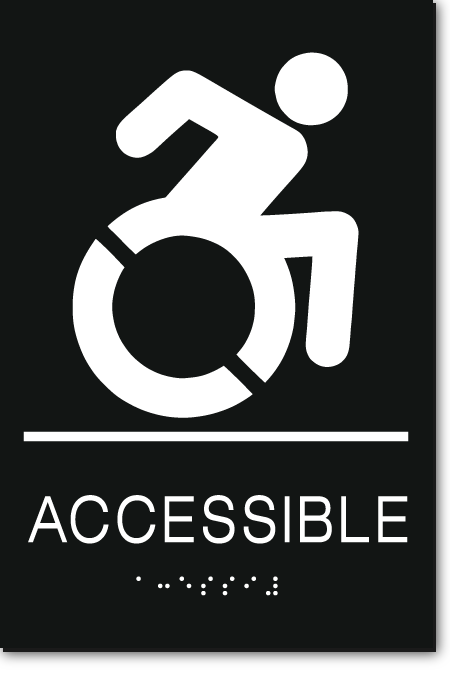Exploring the Secret Features of ADA Signs for Boosted Availability
In the realm of availability, ADA indications offer as quiet yet powerful allies, guaranteeing that rooms are accessible and inclusive for people with disabilities. By incorporating Braille and responsive aspects, these signs break barriers for the aesthetically damaged, while high-contrast shade plans and readable fonts cater to varied aesthetic demands.
Value of ADA Compliance
Ensuring conformity with the Americans with Disabilities Act (ADA) is essential for cultivating inclusivity and equivalent gain access to in public rooms and offices. The ADA, enacted in 1990, mandates that all public centers, employers, and transportation solutions fit people with disabilities, guaranteeing they appreciate the very same rights and possibilities as others. Compliance with ADA requirements not just fulfills lawful obligations however additionally enhances an organization's online reputation by demonstrating its commitment to diversity and inclusivity.
One of the vital elements of ADA compliance is the implementation of accessible signage. ADA signs are made to make sure that individuals with disabilities can conveniently navigate via areas and buildings.
Furthermore, sticking to ADA regulations can alleviate the threat of potential fines and lawful effects. Organizations that stop working to abide by ADA standards might face lawsuits or penalties, which can be both monetarily burdensome and destructive to their public photo. Thus, ADA conformity is essential to cultivating a fair environment for everybody.
Braille and Tactile Aspects
The consolidation of Braille and tactile components right into ADA signs personifies the principles of access and inclusivity. It is generally put underneath the corresponding message on signage to guarantee that individuals can access the info without aesthetic aid.
Tactile elements extend past Braille and include raised personalities and icons. These parts are created to be noticeable by touch, enabling people to identify area numbers, restrooms, departures, and various other crucial areas. The ADA sets specific standards concerning the dimension, spacing, and positioning of these tactile components to enhance readability and guarantee uniformity throughout different environments.

High-Contrast Color Pattern
High-contrast color pattern play a pivotal duty in improving the visibility and readability of ADA signs for people with visual problems. These plans are important as they take full advantage of the difference in light reflectance in between text and history, guaranteeing that signs are conveniently discernible, also from a distance. The Americans with Disabilities Act (ADA) mandates making use of particular shade contrasts to accommodate those with limited vision, making it a critical aspect of conformity.
The efficacy of high-contrast colors depends on their capacity to stand out in numerous illumination problems, including dimly lit environments and locations with glow. Normally, dark message on a light history or light text on a dark background is utilized to achieve ideal comparison. Black message on a yellow or white history provides a stark visual difference that assists in quick recognition and understanding.

Legible Fonts and Text Dimension
When considering the design of ADA signs, the selection of understandable fonts and appropriate message Get More Information dimension can not be overstated. The Americans with Disabilities Act (ADA) mandates that fonts must be sans-serif and not italic, oblique, script, highly decorative, or of uncommon type.
According to ADA standards, the minimum message height need to be 5/8 inch, and it should boost proportionally with seeing range. Consistency in message size contributes to a natural visual experience, assisting individuals in browsing environments successfully.
Additionally, spacing in between lines and letters is essential to readability. Sufficient spacing prevents personalities from showing up crowded, improving readability. By sticking to these requirements, designers can substantially improve access, guaranteeing that signs serves its intended function for all people, despite their visual capacities.
Efficient Placement Methods
Strategic positioning of ADA signage is necessary for optimizing accessibility and making certain compliance with legal criteria. Properly positioned indications lead individuals see it here with specials needs effectively, helping with navigating in public rooms. Trick considerations consist of distance, elevation, and exposure. ADA standards state that indicators ought to be placed at an elevation in between 48 to 60 inches from the ground to ensure they are within the line of sight for both standing and seated individuals. This typical height variety is essential for inclusivity, making it possible for mobility device individuals and people of varying heights to accessibility info effortlessly.
In addition, indications must be placed adjacent to the lock side of doors to allow very easy identification prior to access. Uniformity in indication placement throughout a facility boosts predictability, minimizing complication and improving general user experience.

Final Thought
ADA indications play a crucial role in promoting ease of access by integrating features that address the demands of people with impairments. These aspects collectively foster an here are the findings inclusive setting, emphasizing the relevance of ADA conformity in making sure equivalent gain access to for all.
In the realm of ease of access, ADA indications serve as quiet yet effective allies, guaranteeing that spaces are inclusive and accessible for people with specials needs. The ADA, enacted in 1990, mandates that all public facilities, companies, and transport services accommodate people with impairments, ensuring they appreciate the exact same legal rights and opportunities as others. ADA Signs. ADA indicators are created to guarantee that individuals with handicaps can quickly browse via rooms and structures. ADA guidelines specify that indications need to be mounted at an elevation between 48 to 60 inches from the ground to guarantee they are within the line of sight for both standing and seated people.ADA indications play an important duty in promoting access by incorporating features that resolve the requirements of people with impairments
Comments on “Discover the Importance of ADA Signs in Public Spaces”